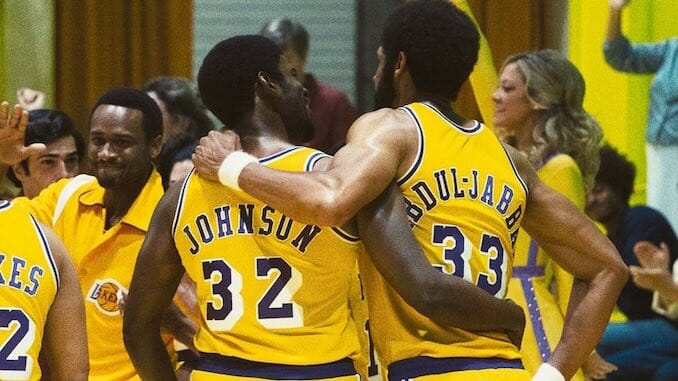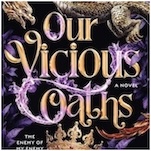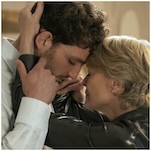Winning Time: The Rise of the Lakers Dynasty Is a Flashy, Raunchy, Star-Studded Spectacle
Photo Courtesy of HBO
Forget the stacked all-star cast. Forget the comedic pedigree behind the camera. Forget, even, the splashy decade of complete Lakers dominance that inspired the show in the first place. The thing that will strike you hardest when you tune in to the first episode of Winning Time: The Rise of the Lakers Dynasty, which debuts on HBO this coming Sunday, is that television? It’s a visual medium.
Okay, so, that may not sound like the wild revelation I set it up to be. I mean, of course television is a visual medium! It’s literally right there in the name! But for all that the narrative integrity of every film and television project produced since the Lumière brothers first screened La Sortie de l’usine Lumière à Lyon has hinged (at least in theory) on the visual elements afforded by the invention of the moving picture, it’s nevertheless rare for a television show to appear that doesn’t just “hinge” on the interplay of lighting, costuming, shot composition, editing, film texture, etc., but genuinely suffers from the viewer glancing away from that interplay for even a second.
And that, from its very first scene—a series of extreme, period-accurate close-ups of people sitting in the waiting room of a busy doctor’s office at Cedars-Sinai on November 5, 1991—is what Winning Time does. It’s not just the deeply ‘90s U.S. News & World Report cover story on the crisis in the Middle East (“Saddam Hussein: The Real Target?”) that director/Executive Producer Adam McKay wants you to take note of as he sets the scene, nor the blocky gray Gameboy fitted with an NBA All-Star Challenge cartridge being played by a red-headed tween clad in an oversized bright purple and gold Lakers jersey. It’s not the tiny CRT waiting room TV airing an interview with an astonishingly young Brooke Shields. It’s not even the low-level hum of digital beepers and landline telephones ringing in the background as these mini tableaux start to add up to something significant.
No, it’s the quality of the film itself. The texture. All those little bits of set dressing I listed above, they’re critical, sure. But what stands out most about them—truly, what all but slaps you in the face—is the fact that they look like they were literally filmed in 1991: soft edges, slightly desaturated colors, flat lighting, the lot. You could turn around and splice that entire waiting room scene into an episode of Doogie Howser, M.D., and no one would be the wiser. Same, too, the more documentary-style handheld close-ups that take over once the scene shifts to a tan-suited Magic Johnson (Quincy Isaiah), nervously wringing his hands in an exam room while waiting for his ride to pull up out back, away from the paparazzi. Honestly, if you didn’t know any better, you could easily be tricked into thinking you’re getting a sneak peek at the real Magic Johnson docuseries. set to come out on Apple TV+ next month. (That Isaiah, a relative newcomer in Hollywood, looks uncannily like the real Johnson, certainly doesn’t help.)
While the action immediately following the series’ unskippable title sequence flings the story back to 1979, this assiduous adherence to period-accurate texture remains. For all the time we spend in the Lakers 1979-1980 season in Winning Time’s first eight episodes (provided to critics for review, out of an eventual ten), this means more graininess, a warm golden tint across everything, and flashes of natural light that wash out whatever it is we’re supposed to be looking at as often as it illuminates it. Moreover, just like in that 1991 opening scene, the types of period-accurate shots that showrunner Max Borenstein, cinematographers Todd Banhazl and Mihai Malaimare Jr., and the series’ small stable of directors use constantly shift between “1979 TV show” (think: Charlie’s Angels) “1979 archival footage” (think: Lakers at Celtics, 1980) and “1979 hand-held documentary footage” (think: every home video parents shot of their Xennial kids). And when I say these textures are constantly shifting, I don’t just mean from one scene to the next, or even from one shot to the next. More often than not, the textures will shift multiple times within the same frame.
Taken altogether, this approach to telling the story of the Lakers’ meteoric rise is deeply fascinating. It also makes it nearly impossible to get the full Winning Time experience if your eyeballs aren’t glued to the screen 100% of the time. And that’s without me even mentioning the microsecond flashes of pop culture moments, fictional memories, news clips and reaction shots that are squeezed in throughout, or the occasional explanatory text that gets slapped on the screen whenever a surprisingly famous character (say, Paula Abdul) or shocking historical detail (say, Nike’s stock valuation thirty years after Phil Knight first met with Magic) is at risk of not being clocked by the audience, or, even, the raw magnetism of each member of the story’s sprawling cast. But that’s exactly the point: it’s a critically rich visual text!
Of course, visual maximalism is, at this point, something of a calling card for HBO. As my fellow Paste TV contributors are well aware, one of my favorite things to rant about is the fact that, much as HBO superfans might act otherwise, Euphoria didn’t invent the teen soap wheel, nor Westworld the sci-fi western one, nor Game of Thrones that of the epic fantasy. (What did they invent? Genre storytelling with massive budgets.) But even I can’t argue that they haven’t all left an aesthetic mark on popular culture. Similarly, while Winning Time hasn’t invented the sports docudrama, I can’t see a future in which it doesn’t set a visual standard by which all sports docudramas (at least in the near term) will be compared.
At this point, I realize we’re nearly a thousand words into this review and I have yet to discuss in any real detail A) the cast, B) the story (and the historical accuracy thereof), or C) the basketball. Apologies. But also, I have a good reason: It’s hard!
-

-

-

-

-

-

-

-

-

-

-

-

-

-

-

-

-

-

-

-

-

-

-

-

-

-

-

-

-

-

-

-

-

-

-

-

-

-

-

-








































